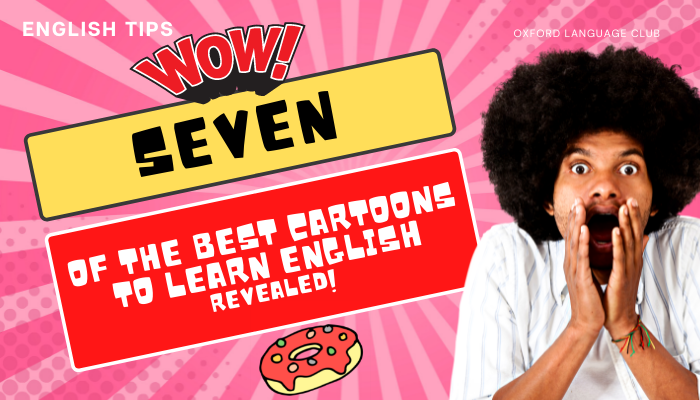Great site to keep my english skills updated for work and travel. I am really enjoying the lessons!
Maria C
 Argentina
Argentina


Cartoons Aren't Just For Kids?!
No way! We grew up watching children's cartoons and, now adults, when we re-watch them we realise how silly they were.
Because of this, we created (sometimes without noticing) a certain prejudice against talking animated characters.
Although many of the cartoons created are aimed at little ones, this is not a rule set in stone.
Many use this aesthetic to present themes a little more adult in a light and comical way, remember cartoons like The Simpsons, Futurama, Family Guy, and many more...
If you are a person who likes to watch cute things, lots of action, or even something more adult... the fact is: cartoons can give you all of that — and much more!
Beginner:
Word Party
Word Party lives up to its name, and its goal is to teach younger viewers new words. The cartoon addresses simple, everyday themes, such as the mysterious arrival of some furniture in the first episode and the characters (Kip, Bailey, Lulu and Franny) investigating the event.
Keep in mind that this is a cartoon aimed at much younger children, so it might seem a little silly to older viewers.
How to use it: if you can understand less than 50% of what they are talking about, try to pay attention to how the characters are acting and what they are feeling. Is anyone sad, angry, hungry…?
Try to understand what's going on so that the character acts that way, and pay attention to the words they use to express themselves.
Dora, the Explorer
Dora is a great cartoon for anyone looking to learn English because not only does she ask for feedback, she also waits for that feedback. Another good point is that nothing is rushed or confusing.
There are enough pauses during the characters' speeches, which means the viewer is not lost at all. The story also unfolds slowly and smoothly, nothing is left misunderstood by the end of the episode.
Listening in the original language, you also learn some of the vocabulary of the Spanish language.
How to use it: make good use of pauses in dialogues so that you can repeat everything the character says. Answer Dora's questions (even if you have to look a little silly doing it!).
Peppa Pig
In the original language, Peppa's family and friends communicate in British English, so it's a good thing for anyone interested in learning it and getting used to its differences in pronunciation and spelling.
How to use it: Pay attention to what each character does, specifically in their daily activities. Focus on the way the character structures their sentence, especially the way they use verbs and nouns.
Intermediate:
Avatar, The Last Airbender
If you are an anime lover, you will definitely love this cartoon - that is, of course, if you haven't seen it before. The Last Airbender brings a mix of epic fights, a dash of romance and a lot of comedy.
How to use it: focus on the characters's dialogues and their own way of talking to each other, using different tones and timbres.
Although each voice actor has a unique voice, they usually speak clearly. Because of that, it's good to watch only with the English subtitles or even take a chance and turn off the subtitles completely.
Disenchantment
For those of you who are fans of The Simpsons, this cartoon is for you.
Disenchantment has a unique atmosphere, and presents a fairy tale in a completely different way than what we are used to.
How to use it: Focus on learning and understanding the jokes used.
Advanced:
SpongeBob SquarePants
SpongeBob is a cartoon aimed at older children, so it has more creative jokes, a vocabulary with a diversity of words and dialogues that change speed and volume in the blink of an eye — it's very common to hear the characters screaming at each other and suddenly they are whispering, and there are many interrupting each other's lines.
How to use it: the characters in SpongeBob SquarePants speak like people do in real life, so pay extra attention to this. For example, the characters cut the words in their speech, the contractions of sentences, such as “gonna”, “wanna”, "watcha”, and many others).
In cartoons and animation aimed at younger children they will not do this, they will say “going to”, “want to” and “what are you”. This shows the differences in formal and informal speech.
Because they can talk very quickly and sometimes in a convoluted way, you may end up not understanding 100% of what is being said. Remember that subtitles are always there to help you!
Voltron, Legendary Defender
Because this is a remake of an old cartoon, older viewers might get a little nostalgic watching it. A group of earthling friends are faced with a great mystery and before they know it they end up discovering alien creatures and gigantic spaceships.
How to use it: notice the use of words related to such things physics and the way they create completely new words to use throughout the show. These words don’t seem that crazy and/or meaningless.